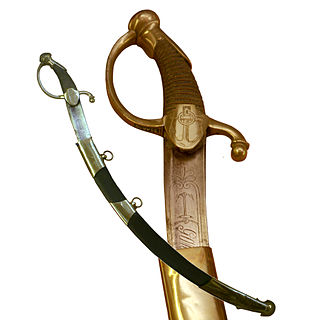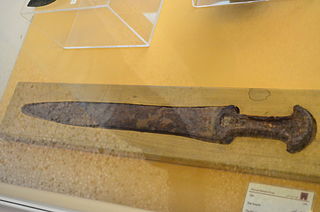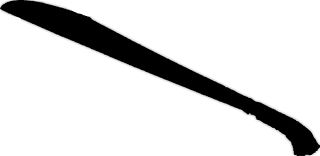
The pulwar or pulouar is a single-handed curved sword originating in Afghanistan.

The pulwar or pulouar is a single-handed curved sword originating in Afghanistan.
The pulwar originated alongside other scimitar-type weapons such as the Arab saif, the Persian shamshir, the Turkish kilij, and the Indian talwar, all of them ultimately based on earlier Central Asian swords. [1] Originally, the Khyber Knife (a type of short sword) served as the weapon of the common people while upper-classes could afford to import swords from neighbouring Persia and India. Over time, the Afghans combined characteristics of the imported swords and adapted it to create the pulwar. Most existing pulwars date back to the early 19th century.

Borrowing features from the swords of neighboring lands, the pulwar may be described as an Afghan version of the Indian talwar. Pulwar blades tend to be more elaborately fullered than those of the talwar. Some pulwar hilts were fitted to Persian blades which are slimmer and more curved and tapered towards the tip than the more typically robust pulwar blades. The hilt is characterized by two quillons which are short and turned to point in the direction of the blade in the manner of some shamshir and saif, a feature typical of swords produced in Qajar period Iran. Like the tulwar, the hilt is made of iron, and is attached to the tang of the blade by a very strong adhesive resin. Unlike the flat disc surrounding the pommel of the tulwar, the pommel of pulwar exhibits a cup-shape. [2] Both hilt and blade can be ornately engraved with inscriptions, designs, and images.
A sword is an edged, bladed weapon intended for manual cutting or thrusting. Its blade, longer than a knife or dagger, is attached to a hilt and can be straight or curved. A thrusting sword tends to have a straighter blade with a pointed tip. A slashing sword is more likely to be curved and to have a sharpened cutting edge on one or both sides of the blade. Many swords are designed for both thrusting and slashing. The precise definition of a sword varies by historical epoch and geographic region.

A sabre is a type of backsword with a curved blade associated with the light cavalry of the early modern and Napoleonic periods. Originally associated with Central European cavalry such as the hussars, the sabre became widespread in Western Europe during the Thirty Years' War. Lighter sabres also became popular with infantry of the early 17th century. In the 19th century, models with less curving blades became common and were also used by heavy cavalry.
This is a list of types of swords.
A longsword is a type of European sword characterized as having a cruciform hilt with a grip for two-handed use, a straight double-edged blade of around 85 to 110 cm, and weighing approximately 1 to 1.5 kg.

A shamshir is a type of Persian/Iranian sword with a radical curve. The name is derived from the shamshīr, which means "sword" in the Persian language. The curved "scimitar" sword family includes the shamshir, kilij, talwar, pulwar and nimcha.

Swordsmanship or sword fighting refers to the skills of a swordsman, a person versed in the art of the sword. The term is modern, and as such was mainly used to refer to smallsword fencing, but by extension it can also be applied to any martial art involving the use of a sword. The formation of the English word "swordsman" is parallel to the Latin word gladiator, a term for the professional fighters who fought against each other and a variety of other foes for the entertainment of spectators in the Roman Empire. The word gladiator itself comes from the Latin word gladius, which is a type of sword.

A kilij is a type of one-handed, single-edged and moderately curved scimitar used by the Seljuk Empire, Timurid Empire, Mamluk Empire, Ottoman Empire, and other Turkic khanates of Eurasian steppes and Turkestan. These blades developed from earlier Turko-Mongol sabers that were in use in lands controlled or influenced by the Turkic peoples.

The talwar, also spelled talwaar and tulwar, is a type of curved sword or sabre from the Indian subcontinent.

The acinaces, also spelled akinakes or akinaka is a type of dagger or short sword used mainly in the first millennium BC in the eastern Mediterranean region, especially by the Medes, Scythians, Persians and Caspii, then by the Greeks.

The shashka or shasqua, is a kind of sabre; single-edged, single-handed, and guardless backsword. In appearance, the shashka is midway between a typically curved sabre and a straight sword. It has a slightly curved blade, and can be effective for both cutting and thrusting.

A kalis is a type of double-edged Filipino sword, often with a "wavy" section. The kalis has a double-edged blade, which is commonly straight from the tip but wavy near the handle. Kalis with fully straight or fully wavy blades also exist. It is similar to the Javanese keris, but differs in that the kalis is a sword, not a dagger. It is much larger than the keris and has a straight or slightly curved hilt, making it primarily a heavy slashing weapon.

A shotel is a curved sword originating in Ethiopia and Eritrea. The curve on the blade varies from the Persian shamshir, adopting an almost semicircular shape. The blade is flat and double-edged with a diamond cross-section. The blade is about 40 inches (1,000 mm) in total length and the hilt is a simple wooden piece with no guard. The shotel was carried in a close fitting leather scabbard.

The Flyssa is a traditional edged weapon of Algeria produced and used during the 19th century and earlier. It originates from the Kabyle Iflissen Lebhar tribal confederacy.

The khanda is a double-edge straight sword originating from the Indian subcontinent. It is often featured in religious iconography, theatre and art depicting the ancient history of India. It is a common weapon in Indian martial arts. Khanda often appears in the Sikh, Jain, Buddhist and Hindu scriptures and art.

A scimitar is a backsword with a convex curved blade associated with Middle Eastern, South Asian, or North African cultures. A European term, scimitar does not refer to one specific sword type, but an assortment of different Eastern curved swords inspired by types introduced to the Middle East by Central Asian ghilmans. These swords include the Persian shamshir, the Arab saif, the Indian talwar, the North African nimcha, and the Turkish kilij. All such swords being originally derived from earlier curved swords developed in Turkic Central Asia (Turkestan).

The firangi (Marathi:फिरंगाना) was an Indian sword type which used blades manufactured in Western Europe, particularly Solingen, and imported by the Portuguese, or made locally in imitation of European blades.

Mughal weapons significantly evolved during the ruling periods of Babur, Akbar, Aurangzeb and Tipu Sultan. During its conquests throughout the centuries, the military of the Mughal Empire used a variety of weapons including swords, bows and arrows, horses, camels, elephants, some of the world's largest cannons, muskets and flintlock blunderbusses.

Niabor is a curved sword from Borneo, a characteristic weapon of the Sea-Dayaks.

The bangkung or bangkon, is a short sword originating in the Sulu Archipelago of the Philippines. The bangkung was used primarily by the Moro people of the Sulu and is not associated with Moros in other areas such as Mindanao, although it is sometimes found in coastal regions. The bangkung is a slashing weapon, meant to deliver hacking type blows. While the bangkung is a very effective sword, it was not popular unlike the panabas and the pirah and for this reason it is one of the most rarely found Moro edged weapons. Few were produced and even fewer survive.

These swords were used by the Turkic nomads of the Eurasian steppes primarily between the 8th and 14th centuries. One of the earliest recorded sabres of this type was recovered from an Avar grave in Romania dating to the mid 7th century. Although minor variations occur in size and hilt, they are common enough in design across 5 centuries that individual blades are difficult to date when discovered without other context.